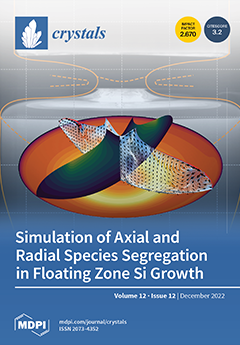The Al-Si-Cr-Co-Ni High Entropy Alloy (HEA) with low density (about 5.4 g/cm
3) and excellent performance had significant potential in the lightweight engineering material field. To further research and optimize the Al-Si-Cr-Co-Ni system HEA, the influences of element Cr on the microstructures
[...] Read more.
The Al-Si-Cr-Co-Ni High Entropy Alloy (HEA) with low density (about 5.4 g/cm
3) and excellent performance had significant potential in the lightweight engineering material field. To further research and optimize the Al-Si-Cr-Co-Ni system HEA, the influences of element Cr on the microstructures and performances of lightweight AlSi
0.5Cr
xCo
0.2Ni (in mole ratio, x = 1.0, 1.2, 1.4, 1.6, and 1.8) HEAs were investigated. The experiment results manifested that AlSi
0.5Cr
xCo
0.2Ni HEAs were composed of A2 (Cr-rich), B2 (Ni-Al), and Cr
3Si phases, indicating that the addition of Cr did not result in the formation of a new phase. However, ample Cr increased the Cr
3Si phase composition, further ensuring the high hardness (average HV 981.2) of HEAs. Electrochemical tests demonstrated that HEAs with elevated Cr
3Si and A2 phases afforded greater corrosion resistance, and the improvement in corrosion was more pronounced when x > 1.6. This work is crucial in the development of lightweight engineering HEAs, which are of tremendous practical utility in the fields of cutting tools, hard coating, etc.
Full article





